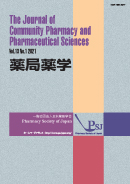Volume 13, Issue 1
Displaying 1-12 of 12 articles from this issue
- |<
- <
- 1
- >
- >|
Reviews
-
2021Volume 13Issue 1 Pages 1-10
Published: 2021
Released on J-STAGE: April 27, 2021
Advance online publication: February 12, 2021Download PDF (5954K) -
2021Volume 13Issue 1 Pages 11-18
Published: 2021
Released on J-STAGE: April 27, 2021
Advance online publication: March 23, 2021Download PDF (8058K)
Original Articles
-
2021Volume 13Issue 1 Pages 19-26
Published: 2021
Released on J-STAGE: April 27, 2021
Advance online publication: November 11, 2020Download PDF (542K) -
2021Volume 13Issue 1 Pages 27-38
Published: 2021
Released on J-STAGE: April 27, 2021
Advance online publication: January 13, 2021Download PDF (1146K) -
2021Volume 13Issue 1 Pages 39-45
Published: 2021
Released on J-STAGE: April 27, 2021
Advance online publication: February 10, 2021Download PDF (1468K)
Notes
-
2021Volume 13Issue 1 Pages 46-53
Published: 2021
Released on J-STAGE: April 27, 2021
Advance online publication: December 16, 2020Download PDF (651K) -
2021Volume 13Issue 1 Pages 54-61
Published: 2021
Released on J-STAGE: April 27, 2021
Advance online publication: December 07, 2020Download PDF (1184K) -
2021Volume 13Issue 1 Pages 62-67
Published: 2021
Released on J-STAGE: April 27, 2021
Advance online publication: February 09, 2021Download PDF (402K) -
2021Volume 13Issue 1 Pages 68-78
Published: 2021
Released on J-STAGE: April 27, 2021
Advance online publication: March 10, 2021Download PDF (1198K) -
2021Volume 13Issue 1 Pages 79-85
Published: 2021
Released on J-STAGE: April 27, 2021
Advance online publication: March 25, 2021Download PDF (716K) -
2021Volume 13Issue 1 Pages 86-97
Published: 2021
Released on J-STAGE: April 27, 2021
Advance online publication: February 17, 2021Download PDF (3680K)
Case Report
-
2021Volume 13Issue 1 Pages 98-105
Published: 2021
Released on J-STAGE: April 27, 2021
Advance online publication: December 07, 2020Download PDF (1546K)
- |<
- <
- 1
- >
- >|
